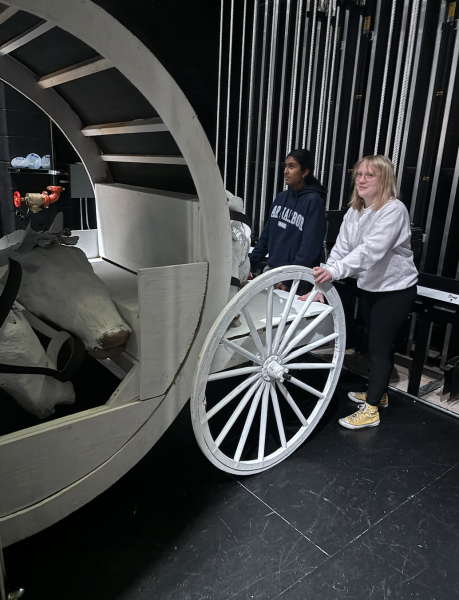Week dedicated to bring awareness to eating disorders
In late 2011 singer and actress Demi Lovato checked into Timberline Knolls Residential Treatment Facility in Illinois. Soon after her release from treatment, she publicly announced her struggle with an eating disorder on Good Morning America with Robin Roberts. Then nineteen year old Lovato admitted to having bulimia since she was twelve. She reflected on her experiences publicly which was not something most would feel comfortable doing. Her revelation to her struggles encouraged others in the media to admit their issues with eating disorders. ABC reporter and talk show host Katie Couric admitted to having an eating disorder from the time she was 18 to 24. Lovato believes that the distorted image of beauty displayed in the media led to the bullying she endured throughout elementary and middle school. While both Lovato and Couric received treatment, not all men and women obtain the treatment they need.
An eating disorder is defined as abnormal eating habits such as excessive or little intake of food. The two most common forms of eating disorders are anorexia nervosa, with which one simply does not eat, and bulimia nervosa, with which the ideas of binging and purging takes place. According to nationaleatingdisorders.org, in the United States alone, twenty million women and ten million men will suffer from an eating disorder in their lives.
Revere High School psychology teacher Ellen Friery noted that media and fashion’s impression on young girls may be at fault for girls’ and boys’ need to fit the standard set by models and those in the public eye, which often times in unattainable. In the Victorian era, women began having procedures that would remove one or more of her ribs to make her waist even smaller in the already waist-cinching corsets. It became popular again in the 1970s when it was rumored that singer Cher had the procedure done to achieve a narrower silhouette. This idea of rib removal coincides with the extremity of eating disorders.
The National Eating Disorders Association (NEDA) began National Eating Disorders Awareness (NEDAwareness) week in 2012. The NEDAwareness week was put in place in order to heighten awareness for these disorders. Head of public relations at The National Eating Disorders Association Vicki Greenleaf commented on the mission of the NEDAwareness week.
“The aim of NEDAwareness Week is to ultimately increase outreach and awareness of eating disorders and body image issues, while reducing the stigma surrounding eating disorders and improving access to treatment resources. Eating disorders are serious, life-threatening illnesses—not choices–and it’s important to recognize the pressures, attitudes and behaviors that shape the disorder,” Greenleaf said.
For this year’s NEDAwareness campaign, the slogan is “Everybody Knows Somebody.” The NEDA believes this is an appropriate topic considering the high rates of eating disorders in the world. According to the NEDA, over one half of teenage girls and one third of teenage boys use unhealthy behaviors to control his or her weight such as laxatives, skipping meals, fasting, smoking cigarettes and vomiting. Greenleaf explained the reasoning behind this theme.
“Awareness of eating disorders is certainly spreading, as is the knowledge that eating disorders do not discriminate—anyone can be affected,” Greenleaf said.
Friery believes that the NEDAwareness week will help to better educate people on eating disorders. In a survey done by the NEDA in August of 2010, 86% of people favored schools providing more information to students on eating disorders to better prevent. Friery teaches eating disorders in three sections of her class: adolescent issues, gender issues and psychological disorders. She described how she feels about the NEDAwareness week as well as involving education of these disorders in her class.
“I have found with the heightened awareness, [students] are quicker to identify things within themselves or friends or family. The sooner one can [seek] treatment, the better. We have awareness for obesity, but if you ask someone about anorexia or bulimia, the average person does not really know as much as they should,” Friery said.
The Cleveland Center for Eating Disorders alongside John Carroll University held a “Body Beautiful” seminar on February 25 to commemorate NEDAwareness week. This seminar consisted of a showing of the film “America the Beautiful,” a student art show called “Mirror Images” as well as an expert panel to answer any and all questions. This panel involved doctors from John Carroll University as well as Youngstown State University. New Beginnings Counseling in Akron, Ohio also takes part in NEDAwareness week. They have an event in which those in recovery that have been through the New Beginnings program come and talk about their experiences. New Beginnings did this on February 21. Carolyn Pickler, executive director at New Beginnings, commented on the event.
“Many shared about their experience with us. Many people come into the program scared, apprehensive and not knowing if they want to be there. After they begin to engage in the program, learn skills, and and know that it is a safe, non-judgmental place to share, they learn to appreciate the program and the treatment team. Many have said we have even saved their lives,” Pickler said.
While one cannot blame the media entirely for the development and spread of eating disorders, it is proven that it does play a role. According to nationaleatingdisorders.org, off American, elementary school girls that read magazines, 69% say that the pictures they view make them believe the models’ bodies are the “ideal” body type and 47% say that models pictures in magazines make them want to lose weight. Although the constant comparison of body types between men and women may seem harmless, this internal battle may evolve into something larger. Friery noted the part the media plays in the diagnosis of eating disorders.
“The majority of diagnosed eating disorders are in wealthy, industrialized countries where the media and fashion plays a role. In the United States, we are treating girls as young as eight for eating disorders because they see what is portrayed on Television and in magazines as ideal, which only a small percentage can achieve. The media gets a lot of blame for putting this image in little girls’ minds and watching it manifest by the time they are old enough to understand and be responsible for their own eating habits,” Friery said.\
Lovato stated in her MTV documentary “Stay Strong” about her struggles with eating and self-harm and her time at Timberline Knolls that her disputes with eating has “been a daily battle.” While one cannot recover entirely, the National Eating Disorders Association encourages those suffering to attempt to get the help they deserve. National Eating Disorders Awareness week occurred from February 24 through March 2 2013.










